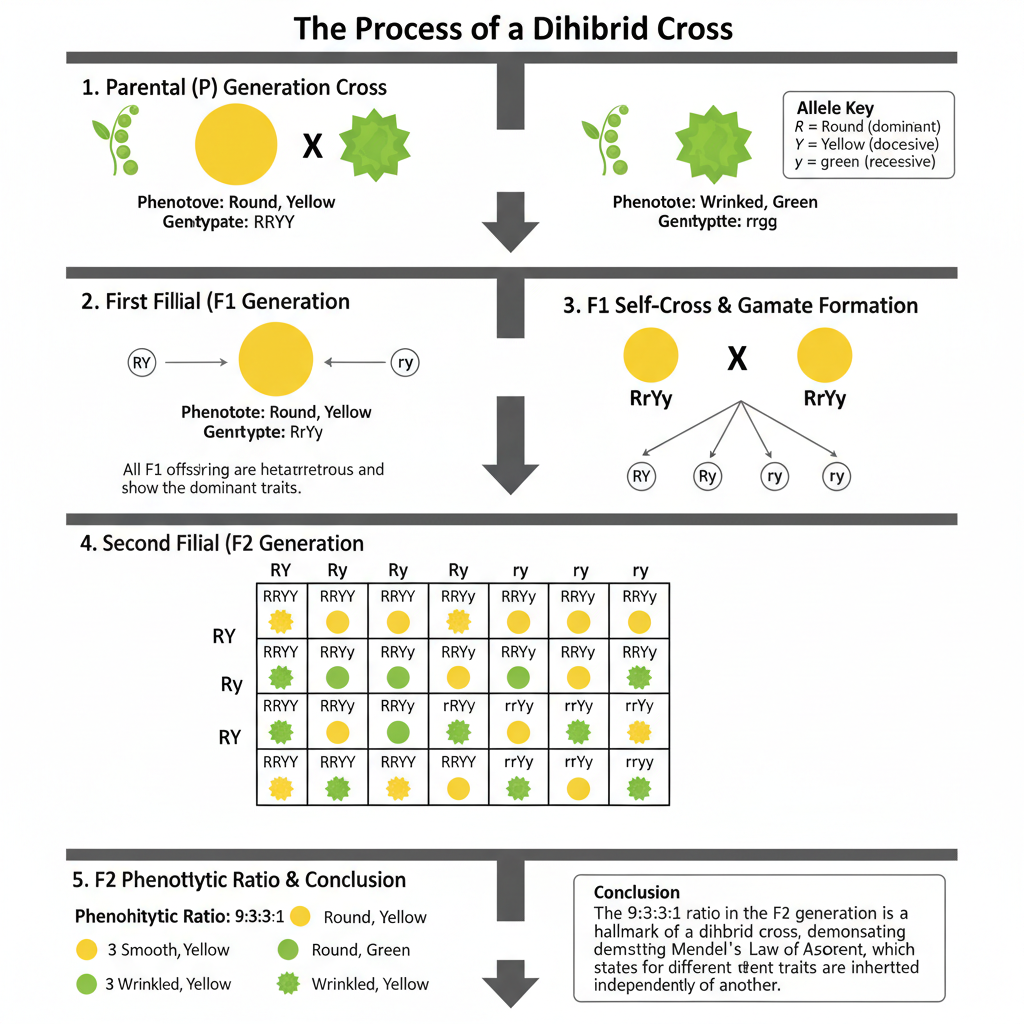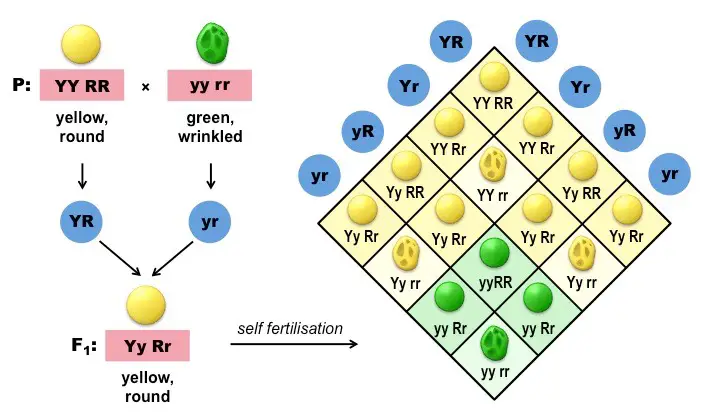A dihybrid cross is a genetic experiment where two organisms that differ in two genetically controlled traits are mated. The traits were governed by separate genes, and the genes had at least two alleles. Mendel first showed this cross type in his experiments on peas, where he combined seed shape and seed color. The dihybrid cross demonstrates the behavior of these traits in inheritance.
By far the main feature of a dihybrid cross is the determination of the assortment of the alleles for two different genes in gametes. When genes are situated on different chromosomes they normally abide by Mendel’s Law of Independent Assortment This law states that the inheritance of one trait does not affect the inheritance of the other. Consequently, the offspring show certain predictable patterns.
The typical dihybrid cross includes double heterozygous parents for both traits and is usually denoted as RrYy × RrYy. The letters stand for dominant and recessive alleles of two independent genes. The parents upon crossing generate gametes harboring all the possible allele combinations. The phenotypic ratios that characterize the experiment originate from this pool of possibilities.
The 9:3:3:1 phenotypic ratio in the F₂ generation is the most cited example of a dihybrid cross result. To be exact, nine out of sixteen total offspring show both dominant traits, three show the first dominant and second recessive trait, three show the first recessive and second dominant trait and one shows both recessive traits. This ratio reaffirms the notion of independent assortment and also offers a structure for the prediction of genetic results.
The genotypic ratios can also be figured out through a dihybrid cross; however, they are rather complicated than the phenotypic ones. The full genotypic ratio 1:2:1:2:4:2:1:2:1 identifies the frequency of each allele combination among the offspring. These configurations result from the random union of the gametes in fertilization. The ratios allow the geneticists to grasp not only the phenotypes but also the cryptic genotypic combinations.
When working with a dihybrid cross, the first step is to recognize each allele and write down the corresponding labels. Normally, dominant alleles are designated by the uppercase letters, while the lowercase letters are for the recessive ones. This symbolic method enables scientists to follow the inheritance stages exactly. Besides, it facilitates the drawing of Punnett squares for the investigation.
Punnett squares are a typical means for the representation of the allele combinations after a dihybrid cross. Due to the presence of two genes, a square is widened to 4 × 4, thus there are sixteen possible genotypes in the offspring. Each cell stands for the fertilization of the gametes which are the products of the parents.
Dihybrid crosses wield tremendous influence on genetics and plant breeding. Through these experiments, scientists are able to tell if two genes are close together or far apart on the chromosome. The departure from the predicted 9:3:3:1 ratio might indicate gene linkage, thus causing more investigation to be done. Therefore, the cross acts as the beginning point to studying the behavior of chromosomes.
Far from being limited to fundamental genetics, dihybrid crosses aid in the comprehension of evolutionary mechanisms as well. They disclose how genetic diversity is generated through the assortment of alleles from one generation to another. This diversity is the fuel of natural selection, thus allowing populations to adapt to the changes of their environment. These implications emphasize the wider significance of Mendelian principles.
On the whole, a dihybrid cross is instrumental in classical genetics. It makes clear the inheritance of the two independent traits as well as how the organisms produce predictable patterns when they reproduce. The method laid down by Mendel is still at the core of the present-day genetic analysis. It owes its central position in the heredity study to both its simplicity and explanatory power.
Definition of Dihybrid Cross
A dihybrid cross is a genetic experiment involving the mating of individuals with differing genetic characteristics for two distinct traits, demonstrating how genes for multiple traits segregate and assort independently during inheritance.
Steps/Process of Dihybrid Cross

1. Selection of Parents
The very first step is the selection of two parents that differ in two different characteristics. These parents are mostly taken from pure lines so that each characteristic is controlled by a homozygous genotype. To confirm the purity self-fertilization for several generations is commonly practiced. The right choice of parents guarantees that the genetic results can be correctly understood.
2. Designation of Alleles for Each Trait
Each allele of the two traits is given one letter symbol. The dominant alleles are represented by uppercase letters, whereas the recessive alleles are written using lowercase letters. The use of this notation makes it easier to follow the genetic combinations during the cross. It also helps in making Punnett squares at a later stage.
3. Determination of Parental Genotypes
Once the alleles are designated, the genotypes of both parents are depicted with these symbols. In a typical Mendelian dihybrid cross, the parents usually carry two heterozygous genotypes for both traits (e.g., RrYy × RrYy). The identification of the correct genotype is a very important step because it determines the types of gametes that will be formed. This step is the basis for the prediction of inheritance patterns.
4. Formation of Gametes
Through meiotic division the alleles segregate independently, and thus the parents form gametes. In case of heterozygous parents, there would be four different gamete combinations (e.g., RY, Ry, rY, ry). If genes assort independently, all gametes are produced in equal proportions. These gametes are the genetic contributions that can be given to the next generation.
5. Construction of the Punnett Square
All possible combinations of the gametes are depicted by drawing a 4 × 4 Punnett square. On the top one-parent gametes are represented, and along the side the other-parent gametes are listed. In each of the sixteen boxes, alleles from the corresponding rows and columns are combined to fill the box. This graphic device makes it easy to see the frequencies of genotypes in the F₂ generation.
6. Identification of Genotypic Combinations
After doing the Punnett square, one genotype corresponds with each box. These genotypes are the combinations of the two dominant and two recessive alleles of the traits. By counting the number of times each genotype occurs one can determine the complete genotypic ratio. This ratio uncovers the core of the genetic variation.
7. Determination of Phenotypes
Each genotype is converted into its corresponding phenotype on the basis of dominant and recessive allele expression. All the sixteen combinations are gone through to find out how many individuals show each combination of traits. These phenotype numbers disclose the total pattern of trait expression. They also demonstrate how independent assortment determines the characteristics that can be seen.
8. Calculation of Phenotypic Ratio
The phenotypes that arise will normally be those predicted by the classical 9:3:3:1 Mendelian ratio for unlinked genes. Nine offspring show the presence of both dominant traits, three show the presence of the first trait as dominant and the second as recessive, three show the presence of the first trait as recessive and the second as dominant, and one shows the presence of both traits as recessive. This ratio is used as proof for independent assortment. Any differences from this pattern may signal that the genes are linked.
9. Interpretation and Analysis of Results
The ultimate step is to make sense out of the observed ratios and compare them to the expected Mendelian values. If the actual results are similar to the predicted ones, the traits most probably assort independently. When there are significant differences, the next step may be to conduct linkage analysis or another type of further study. The analysis of this kind provides support to geneticists’ hypotheses about the inheritance mechanisms.

Examples of Dihybrid Cross
1. Mendel’s Seed Shape and Seed Color Cross
One of the most memorable gene interaction experiments of Gregor Mendel was the duo hybrid of seed shape (round vs. wrinkled) and seed color (yellow vs. green). The experiment involved organisms that were heterozygous for both characters (RrYy × RrYy). The genes segregated independently, thus the phenotypic ratio of the F₂ generation was the classical 9:3:3:1. The example was the basis for the Law of Independent Assortment.
2. Flower Color and Flower Position in Pea Plants
The second Mendelian example includes flower color (purple vs. white) and flower position (axial vs. terminal). The cross of plants that are heterozygous for both traits (PpAa × PpAa) results in 16 genotype combinations. Due to the independent assortment, phenotypic patterns in the progeny can be predicted. Such crosses offer benefits to botanists in studying the segregation of two morphological traits.
3. Fruit Fly Body Color and Wing Shape
The two characters, body color (gray vs. black) and wing shape (normal vs. vestigial), in Drosophila melanogaster are typical subjects in genetic studies. Offspring that result from a cross of the heterozygous flies (BbVv × BbVv) exhibit a combination of both traits. The expected 9:3:3:1 ratio is observed when the genes are unlinked. By using this model organism, scientists can test the classical rules of inheritance.
4. Seed Texture and Pod Color in Pea Plants
Another dihybrid case may involve the characters of seed texture (smooth vs. rough) and pod color (green vs. yellow). What if we crossed SsGg with SsGg? We would get the full range of genotype and phenotype combinations. The resulting offspring display dominant and recessive traits depending on allele interactions. The example from the cross further demonstrates the behavior of two independent genes during meiosis.
5. Human Traits (Hypothetical Example)
While human complex traits are usually polygenic, simple Mendelian examples may be created for pedagogical purposes. For example, consider the traits of unattached vs. attached earlobes and widow’s peak vs. straight hairline, a hypothetical cross of heterozygous parents would be represented as EeWw × EeWw. The assortment of genes occurs independently leading to 16 possible offspring combinations. Simplified examples such as these enable students to grasp dihybrid principles without underestimating the complexity of real human traits.

Uses of Dihybrid Cross
- It helps to study the inheritance of two traits at the same time.
- It shows how alleles assort independently during gamete formation.
- It is used to verify Mendel’s Law of Independent Assortment.
- This helps predict genotype and phenotype combinations in offspring.
- It helps identify whether parents are heterozygous or homozygous.
- It is used to detect genetic linkage when ratios deviate from 9:3:3:1.
- It helps calculate probability of different trait combinations.
- It is used in plant and animal breeding to combine desirable traits.
- This helps in studying gene interactions like epistasis.
- It is used as a teaching tool to explain classical genetic principles.
- Text Highlighting: Select any text in the post content to highlight it
- Text Annotation: Select text and add comments with annotations
- Comment Management: Edit or delete your own comments
- Highlight Management: Remove your own highlights
How to use: Simply select any text in the post content above, and you'll see annotation options. Login here or create an account to get started.